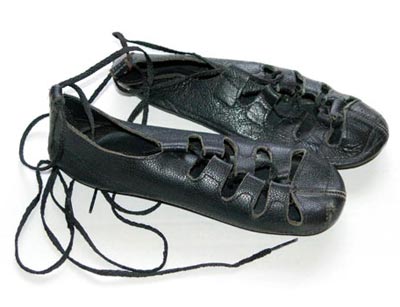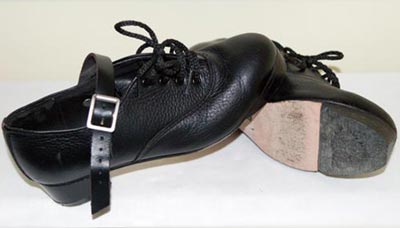Celtic Music - Celtic Rock
The music genre known as Celtic rock has become increasingly popular. Celtic rock is a fusion between Irish traditional music and instruments played in a rock setting. The first successful Celtic rock music band were Thin Lizzy, their hit 'Whiskey in the Jar' was released in 1972 and was the first real rock version of a traditional Celtic song. The song is still popular today and played in pubs and Irish social occasions all over the world. Often Celtic scenes and themes were also used by the artists when performing Celtic Music or in their music videos, Celtic mythology being an extremely popular choice.
Celtic Music - Dance Shoes
Celtic music is often played to accompany solo step dancers. Celtic solo step dancers wear either soft or hard shoes when performing to accompany traditional Celtic music. There are two types of dance shoes used by solo step dancers when dancing the Celtic Music, these are soft shoes (also referred to as ghillies) and hard shoes (often referred to as Hardies), both types of shoe are pictured below:
 Celtic Music - Irish Dancing - Soft Shoes |
 Celtic Music - Irish Dancing - Hard Shoes |

Celtic Music - Harp Instrument
The harp is the national symbol of Ireland, the Celtic harp appears on Irish Currency and features in many Celtic Mythology stories. The most famous harp was called Uaithne and belonged to the Dagda who was an important God in Celtic Mythology. The Dagda was a protector of the people and legend tells us that his magical harp played itself! One of the most famous Irish harp players was Turlough O'Carolan who was blind. Born in Ireland in the 18th century, he was famous for playing the Harp but was also a composer and a singer. He is commonly known as Irelands national composer.
The harp is a multi-stringed instrument, the strings are made from a variety of materials including wire, silk, nylon or gut. The plane of the harp's strings are positioned perpendicularly to its soundboard. Musically the harp is in the category of Chordophones (as are all stringed instruments) but it has its own sub category, Harps. All harps are made up of a neck, resonator and strings. Frame harps also have a pillar, Harps without a pillar are known as open harps. The harp can be played while held in the lap if it is small enough but more often the Harp stands on the floor and the harpist sits next to it on a small chair or stool to play this beautiful Celtic instrument.
Celtic Music - Accordion Instrument
The Accordion was invented by Friedrich Buschmann in 1822 in Berlin, Germany and was called the Handäoline. Cyrill Demian (1772–1847) of Vienna created another version of the accordion with buttons in 1829. His patent of the name 'Accordion' was officially granted in May 1829 and many credit Cyril Demian with the invention of the accordion while others give credit to Friedrich Buschmann's invention. Today there are many variations of the accordion, some with buttons and others with keyboards, essentially they are all constructed in a similar manner, two boxes separated by a bellows.
It is a very popular instrument in modern Celtic folk and traditional music and is available in different forms. The two row button accordion as shown in the picture below is popular with traditional Celtic accordion players. There are several types of accordions available, for example the Melodeon and Concertina versions are also popular in Irish traditional music as well as the piano accordion which is often played by marching bands popular all across Ireland. Traditionally the accordion was popular with the lower classes as opposed to the harp which was played more by the upper classes. The accordion comprises three components, these are:
The Bellows. These are squeezed which in turn pushes air through to the reeds
The Keys or Buttons. These are pressed producing the notes
The Reeds. The reeds vibrate inside the body of the accordion and make the sound
Celtic Music - Image of a Traditional Irish Accordion
Celtic Music - Bodhrán
The Bodhrán is a traditional Celtic musical instrument and consists of a frame drum covered in either synthetic material or goatskin. The inside of the drum is open and the player holds the drum by grasping the cross bars on the inside of the drum as shown as shown in the picture below. The drum is hit with a small wooden bone which is also known as a tipper, beater or cipín. Occasionally the Bodhrán is played by hand.
Celtic Music - Picture of an Irish Bodhrán viewed from the back
Celtic Music - Fiddle
The fiddle is a vital component of Celtic traditional music and it is played in a variety of styles depending on the region of Ireland where the fiddle is played. The regions of Ireland with particular fiddling traditions are Sligo, Donegal, Clare and Sliabh Luachra which is a small area between the counties of Kerry and Cork.
Celtic Music - Picture of an Irish Fiddle (Gaelic: Fidil)
Celtic Music - Facts
Enya is the most successful Celtic Music female singer in Ireland. Her full name is Enya Brennan (Gaelic: Eithne Ní Bhraonái) and she was born in County Donegal in 1961. She is best know for the iconic song called 'Orinoco Flow (Sail Away)'
U2 released their iconic 'The Unforgettable Fire' album in 1984
Henry VIII of England was believed to be a great lover of Celtic harp music and when he took control of Ireland he had a harp embossed on the currency
The word 'Jig' comes from the French word 'giguer' which means to jump
A light jig is the fastest of all the jigs, danced in ghillies (soft shoes). It is performed in 6/8 time
The Piano Accordion became popular in Ireland in the 1950's and is commonly played in marching bands which are still very popular today
The reel is the most popular Irish dance followed in second place by the jig
The jig was developed in Ireland in the 17th Century
Treble Jigs are performed in hard or heavy shoes and are famous for the stomps and clicks made by the hard shoes
Celtic Rock is a genre created through a fusion between Irish traditional music and rock
Celtic Music